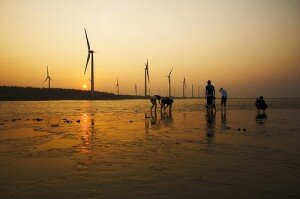
Samso islanders have invested $70 million of their savings and government grants in wind turbines, solar panels and biofuels. Source: flickr
A young boy cooking hot dogs by solar energy, a retired teacher showing his new solar panels on the roof of his house or a farmer being co-owner of a windmill. In a decade the conservative farmer community of Samsø, a small island nestled in the Kattegat Strait, has turned into a case study for sustainable power.
People from all over the world visit the small island in the East of Denmark to see for themselves how this small community of 4100 islanders runs on the energy of twenty-one wind turbines.
Energy independent
Since the islanders have invested $70 million of their savings and government grants in wind turbines, solar panels, biofuels, they became energy independent in ten years. Not only is Samsø CO2 neutral today, the islanders also produce more energy than they consume.
“We wanted to make every islander responsible for his own energy consumption,” said Søren Hermansen, Director of Samsø Energy Academy. “When we started the project nobody could believe that this was really going to happen. But now we can say that this is a dream coming true.”
“Think local, act local”
Hermansen stresses the importance of local projects to lessen the impacts of climate change.
“I would like to change the slogan: ‘think global, act local’, because if everyone changes his behavior on a local scale this will in the end also be better in a worldwide perspective.”
Still, according to the director, the main benefits of the Samsø-project are not the positive effects on the climate. “It particularly provides more jobs and we are more independent,” he says. “We don’t wake up every morning thinking of how we can save the polar bear, but we think about family income. But hopefully in the future projects like this will actually save the polar bear.”
Skeptics
When Samsø was selected to be Denmark’s ‘renewable energy island’ in 1997, many islanders were skeptical.
“In the beginning they said: this sounds nice, but I don’t want to be involved. The project was too alien for this community,” said Hermansen.
To convince the people to be a part of the project Hermansen visited a lot of meetings.
“To convince people, you have to be patient and try to find out who the key persons in the community are. If you can convince them, others will follow.”
Nowadays the local people are very involved in the whole project. “Five off-shore windmills are owned by the Samso municipality and the electricty produced is used for schools, hospitals and traffic lights,” Hermansen illustrates.
“The others are for example owned by a cooperation of local people, or local businesses like farmer companies.”
According to Hermansen the ‘Samsø-case’ is not a utopia, but it can be an example for every other country.
“In a small and well defined community – like the islanders of Samsø – you can easily spread the information to every corner of the area.”
However, the director understands that it is hard to make this happen in the modern society where everyone is part of different communities.
“But I do think it’s possible to learn from this case, to pick out the good and use it in new projects,” he said.
By Martinke Kelder


Recent comments